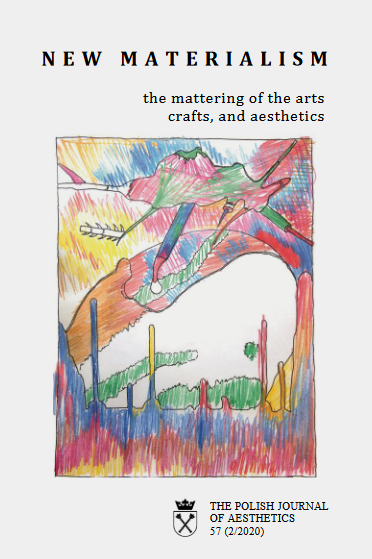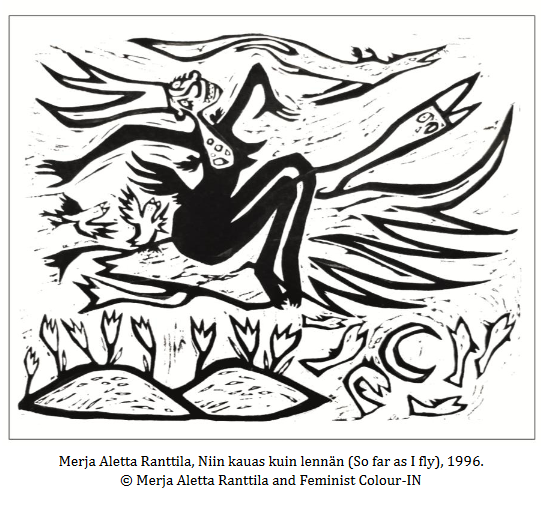Numer 57 (2/2020)
New Materialism. The mattering of the arts, crafts, and aesthetics|
Spis treści
Strony
Pobierz
|
|||||
|
|
|||||
|
INFORMACJE O AUTORACH Katve-Kaisa Kontturi Uniwersytet w Turku, Finlandia Adrian Mróz Uniwersytet Jagielloński w Krakowie Milla Tiainen Uniwersytet w Turku, Finlandia |
|||||
|
Joanna Łapińska
Vibrations of Worldly Matter. ASMR as Contemporary Musique Concrète
DOI: 10.19205/57.20.1
21 – 35
|
|||||
|
Słowa kluczowe new materialism |ASMR |Musique Concrète |Sonic Materialism |VibrationStreszczenie The autonomous sensory meridian response (ASMR) is a sensory phenomenon, sometimes referred to as a “brain orgasm,” which involves pleasant tingling sensations in a body in reaction to certain stimuli. This article analyzes ASMR within the framework of ideas put forward by the musique concrète that offered new sensibilities of musical expression and promoted attentive listening to matter. At the same time, we treat sonic practices of ASMR as inspired by the concepts developed by New Materialism, especially the notions of physicality and materiality of sound recognized within the ontology of its vibrational force. |
|||||
|
Polina Golovátina-Mora
Sprinkles of an Agate Sea-Wave—Multispecies Storying as Creating with Matter
DOI: 10.19205/57.20.2
39 – 54
|
|||||
|
Słowa kluczowe Diffraction |Distributed Knowledge |Networked Reenactment |Speculative Fabulation |StoneworkStreszczenie This article employs diffractive research strategies such as poetic inquiry, storying and speculative fabulation (Haraway 2013) to explore the interplay, or intra-action (Barad 2007), of memories, nostalgias, and material storied with two Instagram channels. The article does not compare these elements, but sees them as parts of a distributed knowledge (King 2011). Informed by Deleuzo-Guattarian nomadic thought and feminist new materialism, the article suggests looking at artwork and crafts as performativity (Barad 2007), networked reenactment (King 2011) and speculative fabulation (Haraway 2013). The article itself takes shape in multispecies entanglements as ways of engaging with vibrant matter. INFORMACJE O AUTORZE
Universidad Pontificia Bolivariana, Medellín, Kolumbia
|
|||||
|
Adrian Mróz
Behaving, Mattering, and Habits Called Aesthetics. Part 1: Theoretical Navigation
DOI: 10.19205/57.20.3
57 – 75
|
|||||
|
Słowa kluczowe Aesthetics |art |Behavioral Aesthetics |new materialism |Behavior |Habits |musicStreszczenie In this two-part article, I propose a new materialist understanding of behavior. The term “mattering” in the title refers to sense-making behavior that matters, that is, to significant habits and materialized behaviors. By significant habits I mean protocols, practices and routines that generate ways of reading material signs and fixed accounts of movement. I advance a notion of behaving that stresses its materiality and sensory shaping, and I provide select examples from music. I note that current definitions of behavior do not capture its material dimension. This is because behavioral science has mostly viewed matter as passive, and not as an active agency. Such an approach has metaphysically framed behavior as a phenomenon of presence that is external from its environment. The approach of behavioral science to matter where there are fixed borders between the internal and external is lacking, since it does not account for agential cuts as conceptualized by Karen Barad. Instead, I consider behavior performatively; as an ongoing iterative practice and as integral to the growth of immanently self-caused matter that spawns metastable relational formations that produce different possibilities for successive formations. In this regard, behavior matters, and matter behaves. One key aspect of my article advances Bernard Stiegler as a critical new materialist thinker. This advancement concerns the technical doings of artworks, which include the material activity that is generative of sensitivity: feelings and beliefs associated with a sense or meaning. I outline an example of the materiality of habits as constitutive of music. After that, I coin the transformative doings of matter on the artist as a “caripulation,” which is a desired movement or motion that transforms the mover and the moved. Finally, I raise “pharmacological” considerations in terms of the Stieglerian aspects of organic and inorganic organized matter. INFORMACJE O AUTORZE
Uniwersytet Jagielloński w Krakowie
|
|||||
|
Adrian Mróz
Behaving, Mattering, and Habits Called Aesthetics. Part 2: Theoretical Cays of Phenomenologically Making-Sense
DOI: 10.19205/57.20.4
77 – 102
|
|||||
|
Słowa kluczowe Aesthetics |art |Behavioral Aesthetics |new materialism |Behavior |Habits |musicStreszczenie Four cays are presented. The first is titled “behavior matters.” It consists of a composition of ideas from a discipline of behaviorism that relate with how behavior is material and how its meaning is actively practiced. Methodological behaviorism views its object of study as external, mechanistic, and separated from an esprit, which can be understood as a characteristic (ethos) or style of habitually be-having and growing exosomatically. Through habits, behaviors have their own material agency and forces of self-replication or selection. The second cay is titled “Oh Behave! The doings of habit or making bodies of art,” which is an account of the problem of sensibility and feeling (aesthetics) in relation to behavior. Phenomenological aspects of habitual retention are raised. This situates behavior as a phenomenon that does not exist, but rather consists with exorganogenesis, which is the production of artificial objects that resist utility or reductions to fixed employment. So, all art is an axiomatic product of behavior... INFORMACJE O AUTORZE
Uniwersytet Jagielloński w Krakowie
|
|||||
|
|
|||||
|
INFORMACJE O AUTORZE
Concordia University, Montreal, Quebec, Kanada
|
|||||
|
|
|||||
|
INFORMACJE O AUTORZE
Université Paris I, Panthéon-Sorbonne, Francja
|
|||||
|
|
|||||
|
INFORMACJE O AUTORZE
University of Denver, USA
|
|||||
|
|
|||||


